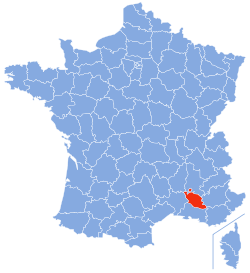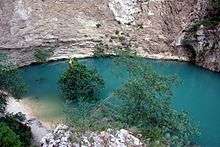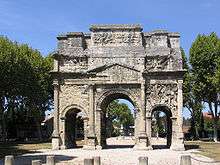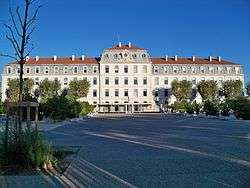Vaucluse
| Vaucluse | ||
|---|---|---|
| Department | ||
|
Prefecture building of the Vaucluse department, in Avignon | ||
| ||
 Location of Vaucluse in France | ||
| Coordinates: 44°00′N 05°10′E / 44.000°N 5.167°ECoordinates: 44°00′N 05°10′E / 44.000°N 5.167°E | ||
| Country | France | |
| Region | Provence-Alpes-Côte d'Azur | |
| Prefecture | Avignon | |
| Subprefectures |
Apt Carpentras | |
| Government | ||
| • President of the General Council | Claude Haut | |
| Area1 | ||
| • Total | 3,567 km2 (1,377 sq mi) | |
| Population (2013) | ||
| • Total | 549,949 | |
| • Rank | 48th | |
| • Density | 150/km2 (400/sq mi) | |
| Time zone | CET (UTC+1) | |
| • Summer (DST) | CEST (UTC+2) | |
| Department number | 84 | |
| Arrondissements | 3 | |
| Cantons | 17 | |
| Communes | 151 | |
| ^1 French Land Register data, which exclude estuaries, and lakes, ponds, and glaciers larger than 1 km2 | ||
The Vaucluse (French pronunciation: [vo.klyz] ; Occitan: Vauclusa in classical norm or Vau-Cluso in Mistralian norm) is a department in the southeast of France, named after the famous spring, the Fontaine-de-Vaucluse. The name Vaucluse derives from the Latin Vallis Clausa (closed valley) as the valley here ends in a cliff face from which emanates a spring whose origin is so far in and so deep that it remains to be defined.
History
Vaucluse was created on 12 August 1793 out of parts of the departments of Bouches-du-Rhône, Drôme, and Basses-Alpes (later renamed Alpes-de-Haute-Provence). The then rural department was, like the nearby city of Lyon, a hotbed of the French Resistance in World War II.
Geography
Vaucluse is bordered by the Rhône to the west and the River Durance to the south. Mountains occupy a significant proportion of the eastern half of the department, with Mont Ventoux (1,912 m), also known as "the Giant of Provence", dominating the landscape. Other important mountain ranges include the Dentelles de Montmirail, the Monts de Vaucluse, and the Luberon. Fruit and vegetables are cultivated in great quantities in the lower-lying parts of the department, on one of the most fertile plains in southern France. The Vaucluse département has a rather large exclave within the Drôme department, the canton of Valréas (Enclave des Papes).

Vaucluse is also known for its karst, including the karst spring Fontaine de Vaucluse after which "Vauclusian Risings" are named.
Important urban centres include Avignon, Orange, Carpentras, Cavaillon, and Apt.
Demographics
- Urban population: 416,301 (83%)
- Rural population: 83,384 (17%)
Tourism


 Gordes, one of the most beautiful villages of France
Gordes, one of the most beautiful villages of France

See also
- Arch of Carpentras
- Arrondissements of the Vaucluse department
- Communes of the Vaucluse department
- Cantons of the Vaucluse department
External links
- Vaucluse at DMOZ
- Official Vaucluse tourism website
- (French) Website of the General Council
- (French) Prefecture website

